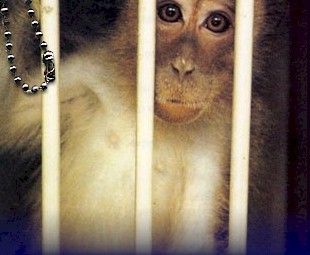






|
||||||||||||||||||||||||||||||||||||||||||||||||||||||||||||||||||||||||||||||||||||||||||||||||||||||||||||||||||||||||||||||||||||||||||||||||||||||||||||||||||||||||||||||||||||||||||||||||||||||||||||||||||||||||||||||||||||||||||||||||||||||
RESPONSE FROM CRPRC MCY23915 Crab-eating Macaque MCY23915 In Memory of No. 23915, As
I read the laboratory notes, I desperately try to imagine what
you must have felt for those twelve years you were trapped inside
the cages at the California Regional Primate Research Center. But
it is difficult to put myself there for even a few seconds; we humans
have such terrible shortcomings. Tears well up in my eyes, but they
will never be enough to give back what we took from you. I can only
apologize for our tremendous sins against you and all the other
animals who continue to be held in research facilities on this earth. My deepest wish is that this insanity will end soon and that
we will one day meet. I will NEVER forget you. Bonnie MCY23915 This was the number tattooed on the monkey who died on June 7,
2000 at the NIH California Regional Primate Research Center (CRPRC),
at the University of California, Davis. The cause was listed on the CRPRC Necropsy Report as “Spontaneous
Death.” Pneumonia was offered as a possible cause. He was
nineteen years, five months old when he died according to this document;
his records do not state a date of birth. The first CRPRC record of MCY23915 was made on January 26, 1988
when he was received and placed in quarantine. According to the
records, he was shivering. Assuming that the CRPRC records are generally
accurate, he must have been about eight years old. We do not know
where he came from or the circumstances of his first eight years,
but he was treated for malaria seven months after he arrived in
Davis, so we imagine that he had been living in some tropical region. The MCY part of MCY23915’s tattoo refers to “Macaca
cynomolgus,” the archaic name given to Macaca fascicularis
within the primate vivisection industry. The accepted common names
for this species are Lion-tailed, or Crab-eating Macaque. These
monkeys normally have a life span of nearly forty years. They live
in groups ranging from ten to a hundred monkeys. They forage for
fruit, the majority of their diet, as well as other plant matter.
These macaques are common in mangrove swamps in Southeast Asia and
catch crabs and other invertebrates exposed during low tide. Crab-eating
macaques, like all macaques, are intensely social and very intelligent. Captive Macaca fascicularis are maintained at a few large
holding facilities in Indonesia and on the island nation of Mauritius
off the coast of East Africa in the Indian Ocean. At these large
facilities, monkeys living on islands are provisioned with food
and allowed to breed un-checked. Their lives are probably similar
to the lives of free monkeys. Animals are periodically “harvested”
for sale to labs around the world. It is likely that MCY23915 was
born and grew up at such a facility. His transportation and three-month-long
quarantine at CRPRC, was probably the first time he had been isolated
from other monkeys. Isolation is a known and industry-wide accepted
cause of distress in macaques. Isolation is a known cause of self-mutilation. Once out of quarantine, MCY23915’s upper canine teeth were
“cut” and a “pulpotomy” performed. His
lower canines were “blunted.” Such procedures are common in the monkey labs. These animals’
only protective device is their teeth. In the close and unnatural
lab conditions, monkeys housed together are unable to escape from
dominant more aggressive animals. The labs’ answer is to
remove or dull the monkeys’ teeth. Doing so also protects
lab workers from monkeys attempting to defend themselves from them. On August 8, 1988, a collar was placed on MCY23915, but no reason
for doing so was noted. Collars are frequently employed with animals
that are handled routinely. Collars allow a worker to affix a pole
to a monkey and move him or her while, at the same time, keeping
the monkey at a safe distance. On January 13, 1989, the collar was removed. The record notes:
“Collar removed. No work order.” On December 18, 1989, MCY23915 was collared again, and then, on
January 9, 1990, he was strapped into a restraint chair and had
his penis shocked in an effort to gather semen. The laboratory jargon
for this is: electroejaculation. In 1992, MCY23915 was injected with levonorgestrel, a hormone,
on three occasions over a four-month period. Levonorgestrel is commonly
used as a “morning after” contraceptive for women
and used in implants for long-term contraception. It has been tested
as a contraceptive in men since at least 1980. The rationale for
injecting it into monkeys, even with much human-derived data available,
remains to be seen. During the twelve years that MCY23915 was held at the NIH California
Regional Primate Research Center at the University of California,
Davis, he was: Chemically restrained at least 43 times with ketamine. [According to the NIH National Institute of Drug Abuse (NIDA):
“Use of Special K [ketamine] can result in profound physical
and mental problems including delirium, amnesia, impaired motor
function and potentially fatal respiratory problems.”] Moved from cage to cage at least seventeen times. [As monkeys are moved from cage to cage, they can be forced into
new social relationships. This is a common and known cause of a
reduced resistance to disease. Such moves also disrupt existing
healthful social relationships. Familiarity with an environment,
or home cage, is recognized as beneficial and less stressful to
monkeys in labs than is frequent disruption of the limited security
offered by familiar surroundings.] “Bled” at least 122 times. [During some weeks, he was bled every day. We know from whistleblowers
at similar NIH facilities, that technicians often feel hurried and
under pressure to get all the animals processed during a typical
day. MCY23915 may have been in the typical “squeeze-back”
cage. When a technician came to take blood, the back wall of the
cage was cranked toward the front pinning MCY23915 to the cage wall.
Repeated attempts to draw blood appear to be common within such
facilities.] MCY23915 was reported to have a poor appetite on a number of occasions
during the time that most of the blood draws were taking place,
but no one could find the cause. On November 14, 1995, an entry
in his record states: “Consider bloodwork. No bloodwork since
October 93!” (sic) He was reported to be very aggressive. No one could figure out
why he was not a good breeder. MCY23915’s story would not have been told without the diligence
and concern of his advocate, Bonnie Redding. Ms. Redding wrote multiple
letters and demanded to know the truth about MCY23915’s life.
CRPRC offered no justification for his repeated harassment or demolished
life. We extend our sincerest thanks to Ms. Redding. MCY23915, rest in peace.
Home Page | Our Mission | News |